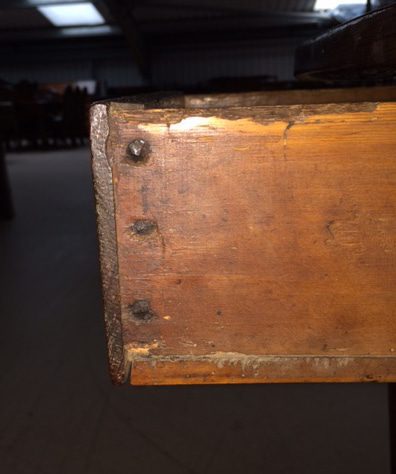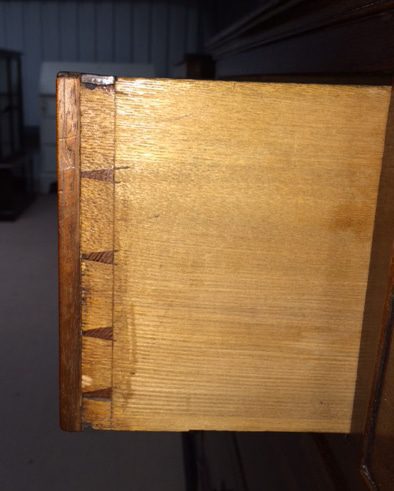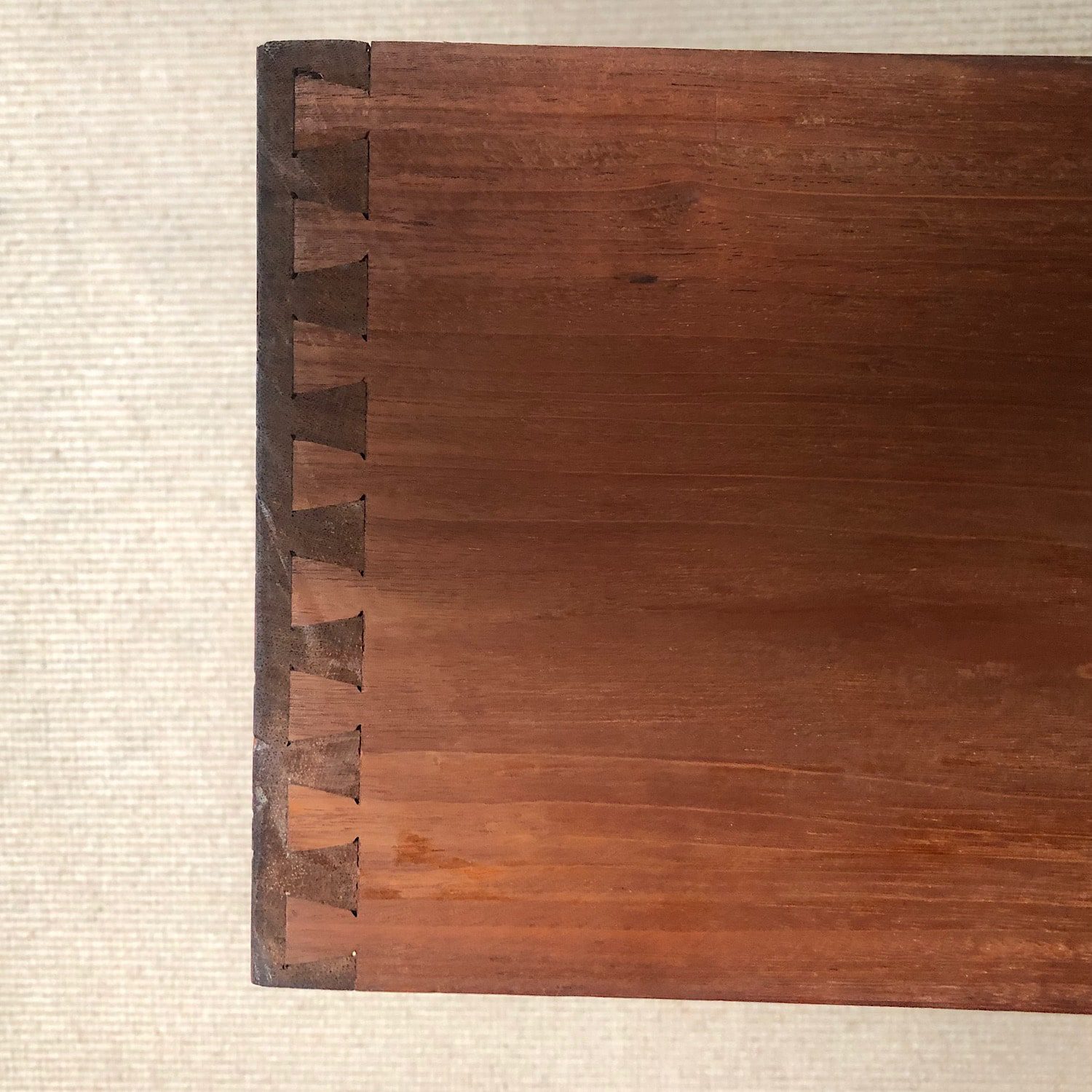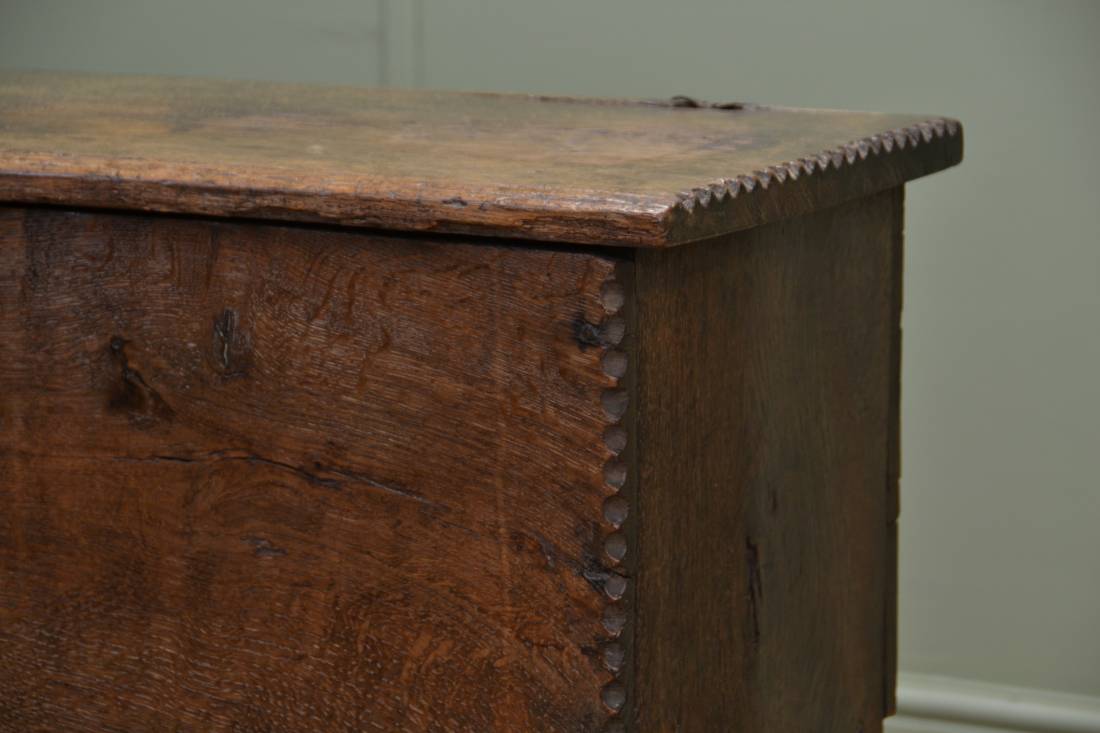Early antique furniture was primitively constructed out of solid, often re-using old pieces of timber. Antique furniture construction, up to the early 1700’s was mainly built using pegged construction (wooden dowels) or simple mortise and tenon joints, also steel clout nails were seen in pieces of antique furniture. During the 17th and 18th centuries the provincial tradition was often slower to change but the construction was becoming more sophisticated, with finely executed joints and the interior was as well made as the exterior. By the early 19th century the prohibitive expense of craftsmanship, though difficult to improve upon, resulted in the rise of the production of machine-assisted furniture and especially used in Edwardian furniture. Below is details of how different types of furniture construction changed through history.
Antique Drawer Construction
Early antique chest of drawers are characterised by their thick sides or ‘linings’, which were usually channelled so that they could run on bars or runners fixed to the sides of the carcass. The angles were usually nailed together, and were sometimes canted. During the 17th century, iron nailed joints were gradually changed to dove tail joints, whereby two sides are joined together by interlocking, triangular shaped wedges. Earlier drawer linings were large, crude and dovetail joints became increasingly small and tight during the second half of the 17th century. Such thin drawer linings could no longer be channelled on the sides, and from the mid 17th century runners were placed beneath the drawers at each side; these ran on further bearers attached to the inside of the carcass. While English antique furniture was usually made with dust boards (generally of pine, that divided and sealed each drawer), French and continental furniture was often left open inside the carcass once the drawers were removed.
What is a Dovetail Joint in Antique Furniture?
Most quality pieces of antique furniture will have a dovetail joint in the drawer construction as it was a very early form of construction, but was so successful, it was used for many 100’s of years. The Dovetail joint, got its name because of its similarity to the shape of a birds tail. The Dovetail joint is a highly skilled bit of cabinet making and is extremely strong and interlocks securely to connect two pieces of wood, usually drawer fronts and sides, or corners on chest carcasses.
Originally they were done by hand, cut using a small saw and chisel, stuck using animal glue. This method can be seen as far back as the Egyptian times found on the furniture entombed with mummies, in pyramids and in furniture built for Chinese emperors.
The English cabinet maker first started using the dovetail joint in the mid 17th Century on walnut furniture and carried on doing this by hand until the late 19th century when they were produced by machines, mainly in the Edwardian periods. This was used in all woods from country pine and Oak to more fine Mahogany and Walnut timbers. You can get an idea of the date of a piece of antique furniture by looking at the dovetail joint, as if it is hand cut you know its pre 1880 and the more primitive the cut usually means an earlier piece.
Below you can see examples, the first is a 17th century drawer, pre dovetail so very primitive clout nails used.

Next is a Georgian drawer with hand cut dovetail and you can see irregularities in the cut and shapes.

Next is an Edwardian dovetail, machine cut, more neat and even in shape.

Antique Chair Construction
Until the end of the 1600s, antique chairs were constructed out of solid timber with pegged tenons. Early English walnut chairs usually had broad, hand sawn rails, but as the 18th century progressed the rails became smoother and narrower. Usually designed with drop-in seats that could be supported on the recessed lips of the wide seat frames (drop in seats), early 18th century English antique chairs are unique in that their legs have tenon joints and are glued but not pegged. The back uprights or were often made of one piece of timber with the back legs, in order to strengthen the chairs. Splat back chairs have uprights that have shaped top rails supported by the vertical baluster splat, similarly tenon joints to top and bottom. The large corner blocks in the corner of Queen Anne chairs were gradually replaced by diagonal cross struts that could also support the drop in seats. This enabled the rails to become increasingly thin and still a good sturdy construction.
Antique Table Construction
Antique tables are traditionally constructed with a fixed top, which is supported on a frame with a frieze and legs. They were initially made in the solid, but from the late 17th century veneering was becoming very popular. The fixed traditional form was very fashionable with ornament but it was not so adaptable to the smaller, lighter tables required for occasional use. The late 1600s saw, two variations of the traditional form of table: the gate leg table and antique occasional tilt top tables.
Antique gate leg tables are characterized by their hinged leaves, which allows flaps to be supported properly when the gate-leg is rotated through 90 degrees. To provide sufficient strength for the solid drop leaves, the central section is firmly secured to the table frame by numerous glue blocks and often by tenoned joints. This form was adapted in the mid 1700s for tables such as Pembroke tables or drop leaf tables, where the lighter leaves were made making it possible to do veneering on, they were supported by a hinged flap. Tilt top tables have hinged tops, which enable them to be stored away or to the side of a room when not in use.
antique centre tables or antique tripod tables during the 17th century, and on larger breakfast and dining tables of the late 18th and 19th centuries, (tilt top tables) were supported on parallel bearers (cross stretchers), which are hinged to the top of the pedestal support by wooden or, on later pieces, brass screw pegs or pins. The tops were designed to be removable for storage or travelling. Some of these tables have a hinged birdcage attached to the top, consisting of two parallel platforms joined by columns, through which the top shaft or column could be inserted and then fixed by a wedge to the neck. Other 18th century tripod tables display a turned wooden screw that fixes the shaft to both top and tripod base; the legs are often bound together by a metal base.

Early English Antique Furniture Pegged Construction
Up to the early 18th century, most early English antique furniture was ‘joined ‘or ‘pegged’ in their construction, using mortise and tenon joints held together by wooden dowels or pegs, or occasionally clout nails. Early wooden pegs were of irregular or square ended in a tapering form; they acted like wedges and tightened the joints as they were hammered in. Over time, shrinkage can happen to the wood and the pegs can be pushed proud of the surface (this is also a good indication that the piece has not been altered at a later date). Later furniture with Pegs in the 19th century are often machine cut and perfectly round and are either flush with the surface or recessed.
From the early 18th century , pegged construction was mostly stopped in Britain, some other countries still did this type of construction after this date and is mainly associated with continental craftsmanship. The best examples of pegged furniture is in an early antique coffer. Below is an example of an early coffer with old pegged dowel on the top right corner.



26 Comments. Leave new
Great! Very informative article!
Great models! Thank you for sharing a very special pieces.
Very nice article thanks for this
Great models! Thank you for sharing a very special pieces.
Great! Very informative article!
Very nice article thanks for this
Very informative!!! Thank you!
Curious, I have a corner curio shelf that is made with threaded wooden dowels and spindles. What Era was threaded dowels used? Is this rare, or just an oddity?
Hi
They have been using dowels in construction for hundreds of years so it would be too difficult to date without looking at the piece.
Thanks
James
Thank you for this page. How about the triangles that are used to give a table stability. They are usually under the table and on a 90 degree angle kinda glueing two sides of the table together. What are those called?
I hope that made sense. Thank you!
Hi
Do you mean Trestles, these are usually seen on Trestle tables or some 20th century refectory tables
Thanks
I have a table with the primitive clout nails pounded through metal all the way around apron. I can’t figure the date of this table it’s just too old. You should see it. It’s very interesting. Not even sure what kind of wood is used
I am wondering when the “Z-shaped” table top fasteners or “buttons” were first introduced. There seems to be an overlap between the use of these and wooden fasteners. Any insights would be appreciated. Thankyou!
Hi
I am not sure of the style that you mean, can you send me a picture?
Thanks
James
I have chairs (lyre style) and the leather seats are fastened with leather pegs. I can’t find any info on what era leather pegs were used. I inherited from my mom who bought them from an antique dealer about 50 years ago. I was having them refinished about 30 years ago and they said they couldn’t put in new leather without removing and replacing the leather pegs (I didn’t know they were leather pegs until then) with something else, so I left the original leather seats
Does the size of dovetail help no the time line?
Smaller neat dovetails are usually machine made so from around 1890 – 1900 on-wards. Larger dovetails are usually earlier and especially if they are hand cut, they will be not as neat or have odd cut lines etc.
I hope this helps
James
I just purchase a vanity that is so amazing but I have no idea how old it is. It has dovetail work for the drawers and a gorgeous mirror with it.
I recently purchased a beautiful antique empire dresser piece. The previous owners did not know much about the age of it just that it’s very old. The dovetails are hand cut because they are different sizes and not neat at all but still sturdy. No markings are on the dresser, unfortunately, so I have no lead on who made it or where. I found this website to gain more knowledge about vintage and antique peices. Thank you for the information you have on your site.
I bought an interesting bookcase that has dowels and wood wedges as shown in your photo for this article. The dowels on the front look round, but the ones on the side are more square with rounded corners. There is another that has a somewhat triangular shape. The dowels are pushed proud, and the bookcase is darkly stained. There does appear to be some wood shrinkage. The side of the drawer had slats of wood, as does the top. I have photos if you are curious.
I have a beautiful furniture set. The dealer I purchased it from in 1990 told me it is from the 1800s. The dovetail joinings are perfect and a probably machine fabricated. The set was not very loved by the previous owners and came with a lot of damage – large chips in paint, busted ratan on the rounded footboards and rocking chair. The set is a buttercup color that really wants to be a creamy white or a midnight black to fit more with my personality. But Im afraid. What would you advise? I want to restore the set but Im not sure if the set is extremely valuable and would lose value if I paint it.
Hi there. I have acquired an old cabinet with the name J.H. Strigger manufacturers Stourbridge on the back. I have tried to find out more about where it has come from but I can not find anything about them and was wondering if you knew anything about them or could point me in the right direction on how to find out more please?
Hi
Sorry I have not seen this maker before. Sorry I can not be of any help with this
James
A few years back I purchased a three drawer drop front secretary. The whole case construction is four pieces of wide planks dovetailed at all four corners to form the box. The drawer dividers are all dovetailed into the sides of the cabinet and left exposed. The case itself sits on a fancy cut out bottom trim. In the corners of the bottom piece are four hand carved chunks of wood that are actually supporting the whole piece. The back was planks fitted. Into each other. The original hardware on the drawers was replaced at some time with round wood knobs. The inside of the desk part has a multitude of cubby drawers along with some hidden drawers. My question is what time period do you think this might have been made? Thanks for your information. Steve
Hi
I would really need to see this in the flesh to offer advice on the date of construction. From the description, it may be an early 19th Century piece but very difficult to tell without seeing it
Many thanks
James
hi. thank you for your post. I just purchased an antique buffet and I’m trying to determine it’s age and value. it is from Henry Jennings and sons Portland Oregon and has Edwardian dovetail. I’ve been searching all over the internet for information I’m not finding much. any help would be appreciated.